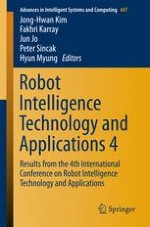This book covers all aspects of robot intelligence from perception at sensor level and reasoning at cognitive level to behavior planning at execution level for each low level segment of the machine. It also presents the technologies for cognitive reasoning, social interaction with humans, behavior generation, ability to cooperate with other robots, ambience awareness, and an artificial genome that can be passed on to other robots. These technologies are to materialize cognitive intelligence, social intelligence, behavioral intelligence, collective intelligence, ambient intelligence and genetic intelligence. The book aims at serving researchers and practitioners with a timely dissemination of the recent progress on robot intelligence technology and its applications, based on a collection of papers presented at the 4th International Conference on Robot Intelligence Technology and Applications (RiTA), held in Bucheon, Korea, December 14 - 16, 2015. For better readability, this edition has the total of 49 articles grouped into 3 chapters: Chapter I: Ambient, Behavioral, Cognitive, Collective, and Social Robot Intelligence, Chapter II: Computational Intelligence and Intelligent Design for Advanced Robotics, Chapter III: Applications of Robot Intelligence Technology .
